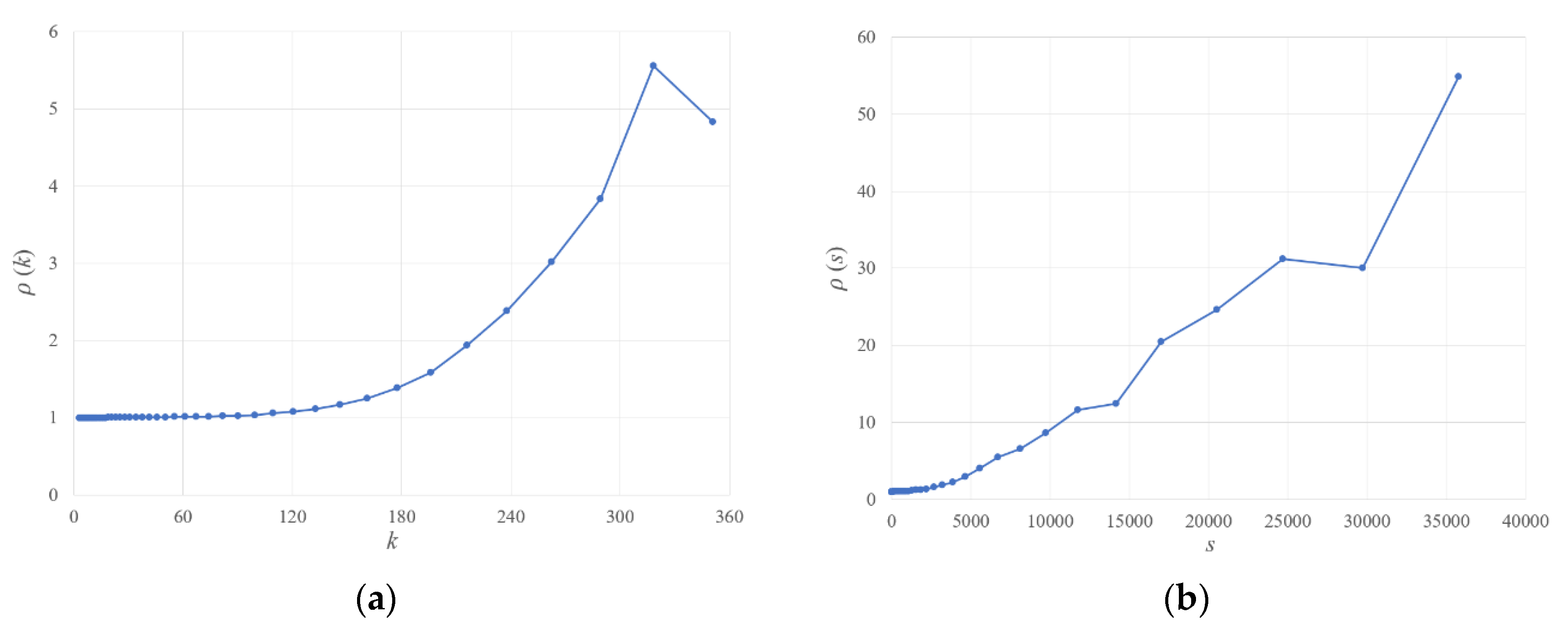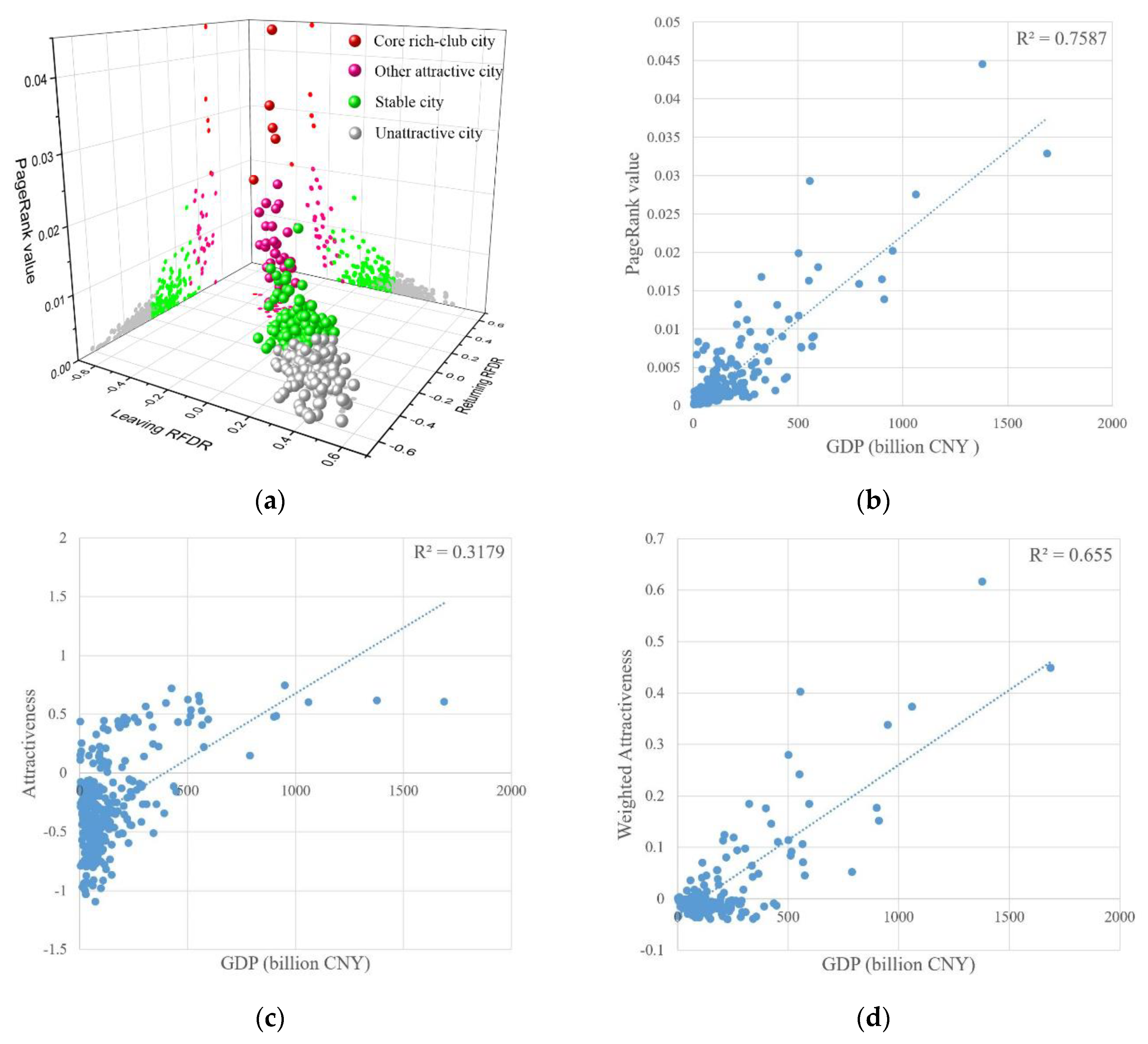Social Sensing of the Imbalance of Urban and Regional Development in China Through the Population Migration Network around Spring Festival
Abstract
1. Introduction
2. Chinese Spring Festival Travel
3. Methodology
3.1. Overall Methodological Framework
3.2. Attractiveness Index Based on Intercity Migration
3.3. Importance Evaluation Based on the PageRank Algorithm
3.4. Community Detection
3.5. Rich-Club Coefficient
3.6. Community Evaluation
4. Results
4.1. Imbalance of Urban Development
4.1.1. The Difference in
4.1.2. The Difference in Urban Attractiveness
4.1.3. The Difference in Urban Importance Based on PageRank
4.2. Intercity Interaction Analysis Based on Population Flow
4.2.1. City Communities Based on the Intercity Migration Network
4.2.2. Rich-Club Effect
4.3. Imbalance of Regional Development
5. Discussion
5.1. Indices of Urban Development Based on PMN
5.2. Rich-Club Cities with Interregional Connections
5.3. City Communities with Urban Agglomeration Planning
6. Conclusions
Author Contributions
Funding
Acknowledgments
Conflicts of Interest
References
- Combes, P.P.; Lafourcade, M.; Thisse, J.F.; Toutain, J.C. The rise and fall of spatial inequalities in France: A long-run perspective. Explor. Econ. Hist. 2011, 48, 243–271. [Google Scholar] [CrossRef]
- Jeffrey, G. Williamson Regional Inequality and the Process of National Development: A Description of the Patterns. Econ. Dev. Cult. Change 1965, 13, 1–84. [Google Scholar] [CrossRef]
- Perera, L.D.H.; Lee, G.H.Y. Have economic growth and institutional quality contributed to poverty and inequality reduction in Asia? J. Asian Econ. 2013, 27, 71–86. [Google Scholar] [CrossRef]
- Hirschman, A.O. The Strategy of Economic Development; Yale University Press: New Haven, CT, USA, 1958. [Google Scholar]
- Myrdal, G. Political Element in the Development of Economic Theory; Transaction Publishers: Piscataway, NJ, USA, 1990; ISBN 0-88738-827-2. [Google Scholar]
- Perroux, F. Economic Space: Theory and Applications. Q. J. Econ. 1950, 64, 89–104. [Google Scholar] [CrossRef]
- Prebisch, R. Commercial policy in the underdeveloped countries. Am. Econ. Rev. 1959, 49, 251–273. [Google Scholar] [CrossRef]
- Lessmann, C. Spatial inequality and development—Is there an inverted-U relationship? J. Dev. Econ. 2014, 106, 35–51. [Google Scholar] [CrossRef]
- Wang, Y.; Deng, Y.; Ren, F.; Zhu, R.; Wang, P.; Du, T.; Du, Q. Analysing the spatial configuration of urban bus networks based on the geospatial network analysis method. Cities 2020, 96, 102406. [Google Scholar] [CrossRef]
- Wang, Z.; Hu, B. China’s reform and opening-up and international law. Chinese J. Int. Law 2010, 9, 193–203. [Google Scholar] [CrossRef]
- Long, Y.; Zhai, W.; Shen, Y.; Ye, X. Understanding uneven urban expansion with natural cities using open data. Landsc. Urban Plan. 2018, 177, 281–293. [Google Scholar] [CrossRef]
- Feng, Y.; Pu, Y.; Ma, J.; Chen, G.; Wang, J. Research on the change of interprovincial migration flows in China based on network autocorrelation. J. Northwest Norm. Univ. Natural Sci. 2017, 53, 119–127. [Google Scholar] [CrossRef]
- Goodchild, M.F. Citizens as sensors: The world of volunteered geography. GeoJournal 2007, 69, 211–221. [Google Scholar] [CrossRef]
- Shan, J.; Qin, K.; Huang, C.; Hu, X.; Yu, Y.; Hu, Q.; Lin, Z.; Chen, J.; Jia, T. Methods of Crowd Sourcing Geographic Data Processing and Analysis. Geomatics Inf. Sci. Wuhan Univ. 2014, 39, 390–396. [Google Scholar] [CrossRef]
- Finch, K.C.; Snook, K.R.; Duke, C.H.; Fu, K.W.; Tse, Z.T.H.; Adhikari, A.; Fung, I.C.H. Public health implications of social media use during natural disasters, environmental disasters, and other environmental concerns. Nat. Hazards 2016, 83, 729–760. [Google Scholar] [CrossRef]
- Zhang, X.; Li, W.; Zhang, F.; Liu, R.; Du, Z. Identifying urban functional zones using public bicycle rental records and point-of-interest data. ISPRS Int. J. Geo Inf. 2018, 7, 459. [Google Scholar] [CrossRef]
- Griffin, G.P.; Jiao, J. Crowdsourcing Bike Share Station Locations: Evaluating Participation and Placement. J. Am. Plan. Assoc. 2019, 85, 35–48. [Google Scholar] [CrossRef]
- Can, U.; Alatas, B. Big social network data and sustainable economic development. Sustainability 2017, 9, 2027. [Google Scholar] [CrossRef]
- Steed, R.J.; Fuenzalida, A.; Bossu, R.; Bondár, I.; Heinloo, A.; Dupont, A.; Saul, J.; Strollo, A. Crowdsourcing triggers rapid, reliable earthquake locations. Sci. Adv. 2019, 5, eaau9824. [Google Scholar] [CrossRef]
- Zhu, R.; Lin, D.; Jendryke, M.; Zuo, C.; Ding, L.; Meng, L. Geo-tagged social media data-based analytical approach for perceiving impacts of social events. ISPRS Int. J. Geo Inf. 2019, 8, 15. [Google Scholar] [CrossRef]
- Giuffrida, N.; Le Pira, M.; Inturri, G.; Ignaccolo, M. Mapping with stakeholders: An overview of public participatory GIS and VGI in transport decision-making. ISPRS Int. J. Geo Inf. 2019, 8, 198. [Google Scholar] [CrossRef]
- Liu, Y.; Liu, X.; Gao, S.; Gong, L.; Kang, C.; Zhi, Y.; Chi, G.; Shi, L. Social Sensing: A New Approach to Understanding Our Socioeconomic Environments. Ann. Assoc. Am. Geogr. 2015, 105, 512–530. [Google Scholar] [CrossRef]
- Li, J.; Ye, Q.; Deng, X.; Liu, Y.; Liu, Y. Spatial-Temporal Analysis on Spring Festival Travel Rush in China Based on Multisource Big Data. Sustainability 2016, 8, 1184. [Google Scholar] [CrossRef]
- Zhang, L.; Pentina, I. Motivations and usage patterns of weibo. Cyberpsychology Behav. Soc. Netw. 2012, 15, 312–317. [Google Scholar] [CrossRef] [PubMed]
- Tian, X.; Batterham, P.; Song, S.; Yao, X.; Yu, G. Characterizing Depression Issues on Sina Weibo. Int. J. Environ. Res. Public Health 2018, 15, 764. [Google Scholar] [CrossRef] [PubMed]
- Wang, S.; Paul, M.J.; Dredze, M. Social media as a sensor of air quality and public response in China. J. Med. Internet Res. 2015, 17, e22. [Google Scholar] [CrossRef] [PubMed]
- Wang, Y.; Ruan, S.; Wang, T.; Qiao, M. Rapid estimation of an earthquake impact area using a spatial logistic growth model based on social media data. Int. J. Digit. Earth 2018, 1–20. [Google Scholar] [CrossRef]
- Zhang, Y.; Li, Q.; Huang, H.; Wu, W.; Du, X.; Wang, H. The Combined Use of Remote Sensing and Social Sensing Data in Fine-Grained Urban Land Use Mapping: A Case Study in Beijing, China. Remote Sens. 2017, 9, 865. [Google Scholar] [CrossRef]
- Xu, J.; Li, A.; Li, D.; Liu, Y.; Du, Y.; Pei, T.; Ma, T.; Zhou, C. Difference of urban development in China from the perspective of passenger transport around Spring Festival. Appl. Geogr. 2017, 87, 85–96. [Google Scholar] [CrossRef]
- Wei, Y.; Song, W.; Xiu, C.; Zhao, Z. The rich-club phenomenon of China ’ s population flow network during the country ’ s spring festival. Appl. Geogr. 2018, 96, 77–85. [Google Scholar] [CrossRef]
- Jendryke, M.; Balz, T.; Liao, M. Big location-based social media messages from China ’ s Sina Weibo network: Collection, storage, visualization, and potential ways of analysis. Trans. GIS 2017, 21, 825–834. [Google Scholar] [CrossRef]
- Peng, S.; Yang, A.; Cao, L.; Yu, S.; Xie, D. Social influence modeling using information theory in mobile social networks. Inf. Sci. N.Y. 2017, 379, 146–159. [Google Scholar] [CrossRef]
- Sun, Q.; Guo, X.; Jiang, W.; Ding, H.; Li, T.; Xu, X. Exploring the Node Importance and Its Influencing Factors in the Railway Freight Transportation Network in China. J. Adv. Transp. 2019, 2019, 1493206. [Google Scholar] [CrossRef]
- Ramos, A.; Lazar, M.; Filho, R.H.; Rodrigues, J.J.P.C. Model-Based Quantitative Network Security Metrics: A Survey. IEEE Commun. Surv. Tutorials 2017, 19, 2704–2734. [Google Scholar] [CrossRef]
- Page, L.; Brin, S.; Motwani, R.; Winograd, T. The PageRank Citation Ranking: Bringing Order to the Web; Stanford University: Stanford, CA, USA, 1999. [Google Scholar]
- Raghavan, U.N.; Albert, R.; Kumara, S. Near linear time algorithm to detect community structures in large-scale networks. Phys. Rev. E 2007, 76, 036106. [Google Scholar] [CrossRef] [PubMed]
- Wu, Z.; Lin, Y.; Gregory, S.; Wan, H.; Tian, S. Balanced multi-label propagation for overlapping community detection in social networks. J. Comput. Sci. Technol. 2012, 27, 468–479. [Google Scholar] [CrossRef]
- Newman, M.E.J. Modularity and community structure in networks. Proc. Natl. Acad. Sci. 2006, 103, 8577–8582. [Google Scholar] [CrossRef]
- Blondel, V.D.; Guillaume, J.; Lambiotte, R.; Lefebvre, E. Fast unfolding of communities in large networks. J. Stat. Mech. theory Exp. 2008, 2008, P1008. [Google Scholar] [CrossRef]
- Rosvall, M.; Bergstrom, C.T. An information-theoretic framework for resolving community structure in complex networks. Proc. Natl. Acad. Sci. 2007, 104, 7327–7331. [Google Scholar] [CrossRef]
- Rosvall, M.; Bergstrom, C.T. Maps of random walks on complex networks reveal community structure. Proc. Natl. Acad. Sci. 2008, 105, 1118–1123. [Google Scholar] [CrossRef]
- Lancichinetti, A.; Fortunato, S. Community detection algorithms: A comparative analysis. Phys. Rev. E 2009, 80, 056117. [Google Scholar] [CrossRef]
- Yang, Z.; Algesheimer, R.; Tessone, C.J. A comparative analysis of community detection algorithms on artificial networks. Sci. Rep. 2016, 6, 30750. [Google Scholar] [CrossRef]
- Shannon, C.E. A mathematical theory of communication. Bell Syst. Tech. J. 1948, 27, 379–423. [Google Scholar] [CrossRef]
- Huffman, D.A. A method for the construction of minimum-redundancy codes. Proc. IRE 1952, 40, 1098–1101. [Google Scholar] [CrossRef]
- Guimera, R.; Amaral, L.A.N. Functional cartography of complex metabolic networks. Nature 2005, 433, 895–900. [Google Scholar] [CrossRef] [PubMed]
- Clauset, A.; Newman, M.E.J.; Moore, C. Finding community structure in very large networks. Phys. Rev. E 2004, 70, 066111. [Google Scholar] [CrossRef] [PubMed]
- Csardi, G.; Nepusz, T. The igraph software package for complex network research. Int. J. Complex Syst. 2006, 1695, 1–9. [Google Scholar]
- Colizza, V.; Flammini, A.; Serrano, M.A.; Vespignani, A. Detecting rich-club ordering in complex networks. Nat. Phys. 2006, 2, 110. [Google Scholar] [CrossRef]
- De Masi, G.; Iori, G.; Caldarelli, G. Fitness model for the Italian interbank money market. Phys. Rev. E Stat. Nonlinear Soft Matter. Phys. 2006, 74, 066112. [Google Scholar] [CrossRef] [PubMed]
- Zhou, S.; Mondragón, R.J. The Rich-Club Phenomenon in the Internet Topology. IEEE Commun. Lett. 2004, 8, 180–182. [Google Scholar] [CrossRef]
- Opsahl, T.; Colizza, V.; Panzarasa, P.; Ramasco, J.J. Prominence and Control: The Weighted Rich-Club Effect. Phys. Rev. Lett. 2008, 101, 168702. [Google Scholar] [CrossRef]
- Opsahl, T. Structure and Evolution of Weighted Networks; Queen Mary College, University of London: London, UK, 2009. [Google Scholar]
- Long, Y.; Wu, K. Shrinking cities in a rapidly urbanizing China. Environ. Plan. A 2016, 48, 220–222. [Google Scholar] [CrossRef]
- Guo, D. China’s Tibetan population and population in Tibet. China Popul. Today 1996, 13, 7–8. [Google Scholar] [PubMed]
- Miao, Y. Analysis of population change in Hulunbeier City. Inn. Mong. Stat. 2016, 59–61. [Google Scholar] [CrossRef]
- Liu, H.; Du, G. Spatial-temporal pattern of China’s economic development and its dynamic evolution: Based on city level DMSP/OLS night-time lights data. Chin. J. Popul. Sci. 2017, 37, 17–29. [Google Scholar]
- Liu, H.; He, L. Regional disparity in China and its evolution (2000–2012)—Re-examination based on DLI. Rev. Econ. Manag. 2015, 141–146. [Google Scholar] [CrossRef]
- Guan, X.; Fang, C.; Luo, K. Regional economic development disparity of China: An application of spatial field. Sci. Geogr. Sin. 2012, 32, 1055–1065. [Google Scholar] [CrossRef]
- Chang, L. The Current Status and the Development of Tibetan Culture Industry under the Global Horizon. J. Tibet Univ. 2009, 24, 32–37. [Google Scholar] [CrossRef]
- Wu, Y.S. Taiwan’s domestic politics and cross-strait relations. China J. 2005, 35–60. [Google Scholar] [CrossRef]










© 2020 by the authors. Licensee MDPI, Basel, Switzerland. This article is an open access article distributed under the terms and conditions of the Creative Commons Attribution (CC BY) license (http://creativecommons.org/licenses/by/4.0/).
Share and Cite
Zhu, R.; Lin, D.; Wang, Y.; Jendryke, M.; Xin, R.; Yang, J.; Guo, J.; Meng, L. Social Sensing of the Imbalance of Urban and Regional Development in China Through the Population Migration Network around Spring Festival. Sustainability 2020, 12, 3457. https://doi.org/10.3390/su12083457
Zhu R, Lin D, Wang Y, Jendryke M, Xin R, Yang J, Guo J, Meng L. Social Sensing of the Imbalance of Urban and Regional Development in China Through the Population Migration Network around Spring Festival. Sustainability. 2020; 12(8):3457. https://doi.org/10.3390/su12083457
Chicago/Turabian StyleZhu, Ruoxin, Diao Lin, Yujing Wang, Michael Jendryke, Rui Xin, Jian Yang, Jianzhong Guo, and Liqiu Meng. 2020. "Social Sensing of the Imbalance of Urban and Regional Development in China Through the Population Migration Network around Spring Festival" Sustainability 12, no. 8: 3457. https://doi.org/10.3390/su12083457
APA StyleZhu, R., Lin, D., Wang, Y., Jendryke, M., Xin, R., Yang, J., Guo, J., & Meng, L. (2020). Social Sensing of the Imbalance of Urban and Regional Development in China Through the Population Migration Network around Spring Festival. Sustainability, 12(8), 3457. https://doi.org/10.3390/su12083457





